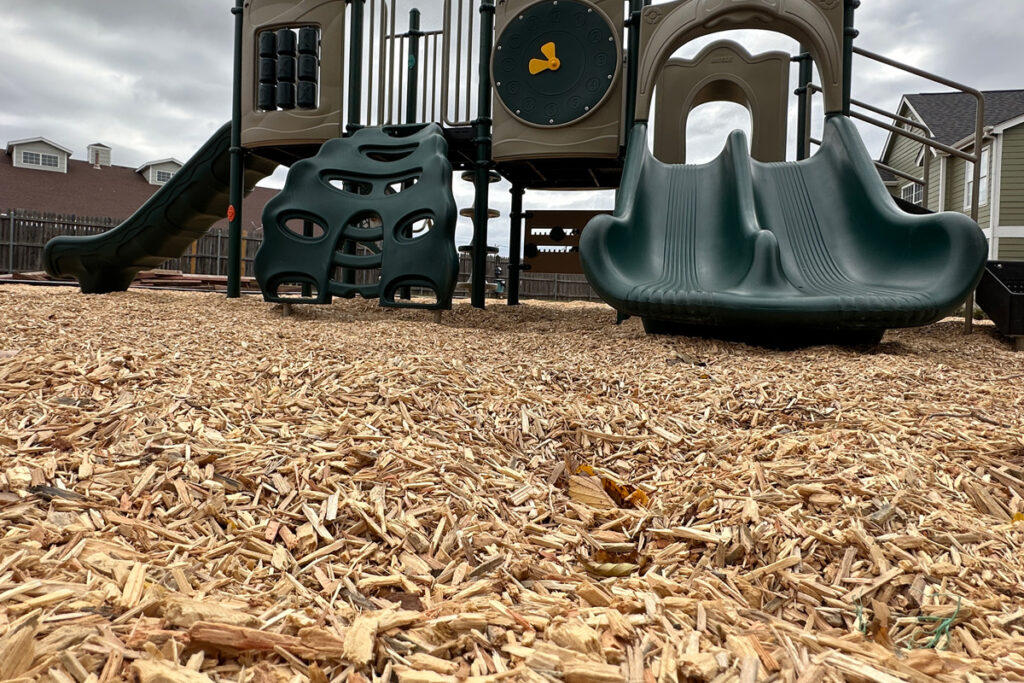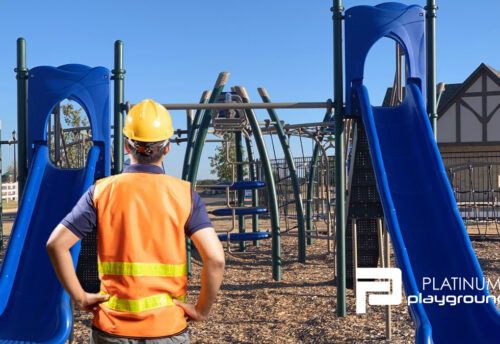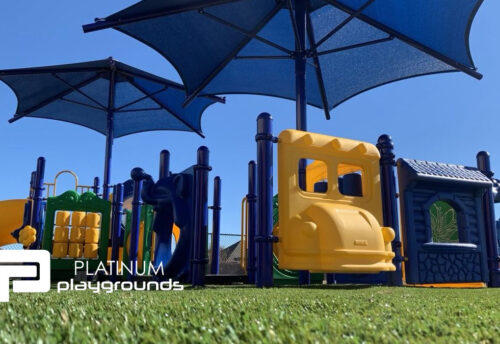Choosing Safety Surfacing for Commercial Playgrounds: Finding Your Grounding
When it comes to playground safety, one of the biggest factors is the surface beneath it all. Kids are going to jump, run, climb, and—let’s face it—sometimes take a spill, and that’s where choosing the right safety surfacing can make all the difference. The right playground surfacing does more than just look good; it absorbs impact, prevents injuries, and stands up to weather, wear, and tear.
“Ensuring Playground Safety“ is job one!
But not all playground surfaces are created equal, so let’s break down some of the top choices, weigh the pros and cons, and help you find the best fit for your playground space. Whether you’re considering rubber, mulch, or sand, this guide will give you the scoop on keeping kids safe and grounded.

Why Safety Surfacing Matters
Imagine landing on concrete after falling off a swing. Not exactly the kind of “playful” experience we’re going for! Safety surfacing is designed to soften the impact when kids jump, trip, or tumble. Each type of surfacing offers unique benefits, so it’s essential to choose one that fits the type of play equipment, average fall height, and the amount of foot traffic.
Not only does the right surfacing reduce injury risk, but it also provides:
- Traction: Avoid slips and keep running children upright.
- Durability: Quality materials last longer, reducing the need for frequent replacements.
- Compliance: Proper surfacing meets safety standards like those from the American Society for Testing and Materials (ASTM) and the Consumer Product Safety Commission (CPSC).
Want to know how much Safety Surfacing material to order for your project? Check out our Safety Surfacing Calculator here.
Top Playground Safety Surfacing Options to Consider
Let’s get into the nitty-gritty of popular safety surfacing options, from rubber to mulch to sand, to help you pick the best surface for your playground.
1. Rubber Surfacing: The Gold Standard of Safety
Rubber surfacing is one of the most popular choices for playgrounds—and for good reason! Not only does it have superior impact-absorbing qualities, but it also comes in various forms, from rubber tiles to poured-in-place (PIP) surfaces.
Pros:
- Excellent Shock Absorption: Rubber surfacing is known for its cushioning abilities, making it ideal for playgrounds with high fall zones.
- Low Maintenance: Rubber doesn’t need frequent raking, leveling, or replenishment.
- Customizable Colors and Designs: Want a fun, colorful play area? Rubber surfacing can be customized with colors, patterns, and even playful designs.
Cons:
- Costly: Rubber surfacing is one of the pricier options, but it pays off in terms of durability and minimal maintenance.
- Temperature Sensitivity: Rubber can get hot in direct sunlight, so shade or coverings are a good idea if you’re in a sunny area.
- Best For: High-traffic playgrounds, playgrounds with tall equipment, or those looking for a long-term, low-maintenance solution.
2. Wood Mulch: Classic and Natural
Wood mulch, also known as engineered wood fiber (EWF), is an affordable and natural-looking playground surface option. It’s made from processed wood, providing a soft, cushioned surface when maintained correctly.
Pros:
- Affordable: Compared to rubber, wood mulch is far more budget-friendly, making it a popular choice for large playgrounds.
- Good Shock Absorption: Provides decent cushioning for falls if it’s kept at the right depth (usually around 12 inches).
- Natural Look: Mulch blends into natural surroundings, making it an aesthetic choice for parks.
Cons:
- High Maintenance: Mulch requires regular raking, replenishment, and leveling to keep it safe and even.
- Less Durable: It can compact over time, reducing its effectiveness at absorbing impact.
- Attracts Critters: Wood mulch can attract insects or rodents, so it’s best to inspect and maintain it regularly.
- Best For: Natural-looking playgrounds, budget-conscious spaces, and areas with medium traffic.
3. Sand: Simple and Affordable
Sand is one of the oldest playground surfacing options out there. It’s soft, affordable, and kids love playing in it, making it a double-duty option for many playgrounds.
Pros:
- Inexpensive: Sand is an affordable option that’s easy to find and replace.
- Soft Landing: If it’s deep enough, sand provides a decent cushion for falls.
- Dual Use: Kids can play in the sand itself, which adds to the playground’s appeal.
Cons:
- Messy: Sand can spread beyond the playground, tracking into other areas and requiring cleanup.
- Low Impact Absorption for High Falls: Sand needs to be consistently deep (at least 12 inches) to provide adequate cushioning for falls from taller structures.
- Attracts Animals: Like mulch, sand can attract critters, and it may need raking to keep it clean and safe.
- Best For: Smaller playgrounds, lower-budget installations, and play areas where children enjoy digging or building.
4. Synthetic Turf: Green and Clean Safety Surfacing
Synthetic turf combines the look of grass with the durability of a playground surface. It’s a popular choice for those who want a natural aesthetic with a bit more safety and resilience than natural grass provides.
Pros:
- Good Drainage: Turf often comes with a built-in drainage system, which is helpful for areas with high rainfall.
- Low Maintenance: No need to mow, water, or fertilize.
- Customizable: Available in different colors and patterns to fit your playground design.
Cons:
- Moderate Cost: Turf is more affordable than rubber but can be pricier than mulch or sand.
- Heat Retention: Like rubber, synthetic turf can get hot in direct sunlight.
- Best For: Areas where aesthetics matter, such as community parks, or where a low-maintenance surface is desired.
Tips for Choosing the Right Surfacing for Your Playground
- Consider Fall Heights: Different surfacing materials are rated for different fall heights, so be sure to choose one that aligns with your equipment.
- Think About Maintenance: Some surfaces (like rubber) are virtually maintenance-free, while others (like sand) need regular attention. Factor in the time and budget available for upkeep.
- Look at Weather Factors: Rubber and turf can get hot in the sun, while mulch and sand can retain moisture after heavy rains. Choose one that works best with your local climate.
- Factor in Accessibility: ADA-compliant surfacing is essential for playgrounds intended to be inclusive. Rubber and synthetic turf often provide easier mobility access compared to mulch or sand.
Check out some other “Top Playground Safety Features to Consider“.
Making Playground Safety Surfacing Work for You
Selecting the right surfacing for your playground is more than just a practical choice—it’s an investment in safety, playability, and appearance. By choosing a material that suits your playground’s unique needs, you’re setting the stage for a fun, safe environment where kids can explore with fewer bumps and bruises.
From rubber that offers unparalleled cushioning to sand that’s both affordable and play-friendly, each material has its strengths. But with so many options, how do you know which is best for your specific playground setup? That’s where the experts at Platinum Playgrounds come in.
Need help deciding? Platinum Playgrounds can guide you through the selection process, offering advice and recommendations tailored to your unique requirements. We’ll make sure your playground has the safest, most durable, and most attractive surfacing for years to come.
Ready to get started? Contact Platinum Playgrounds today to discuss your playground safety surfacing needs and find the perfect option for your space. Let’s create a safer, happier playground together!


